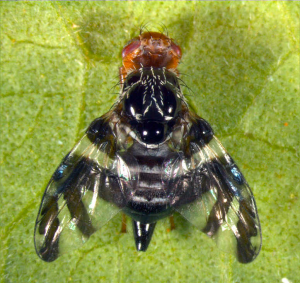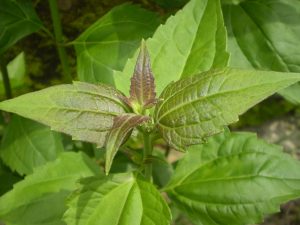THE TARGET: DEVIL WEED (CHROMOLAENA ODORATA)
Devil Weed (Chromolaena odorata)
- Hawaii Pacific Weed Risk Assessment: 28- High Risk
- Chromolaena odorata, also known as devil weed, siam weed, or bitter bush, is one of the most notorious tropical weeds in the world. Emerging as a shrub that quickly forms dense thickets, it can thrive in all environments except deep shade, flourishing in newly disturbed areas. Each plant can grow up to 12 feet tall and produce 800,000 small seeds in a year, which readily disperse via the wind or burrow into clothing, gear, or fur.
- The plant suppresses the growth of other plants (it’s “allelopathic”), allowing it to grow in dense fire-prone thickets in both native forest and agricultural fields choking out all other plant life. If allowed to spread unchecked, it could easily become ubiquitous across dry to mesic-wet environments in Hawai‘i.
- Distribution: C. odorata was first detected in Hawai‘i at the Kahuku Training Area on the north shore of O‘ahu in January 2011. The weed has been found in Kahana Valley, Pūpūkea, and ʻAiea on ʻOahu, and has recently been identified in Hilo and the Puna District on Hawaiʻi island. C. odorata is native to Central and South America and is a well-documented pan-global pest in the tropics worldwide.
- What you can do: If you see this species, call 643-PEST and/or visit 643pest.org.
Report this species if seen anywhere in Hawaiʻi
THE CANDIDATE: Cecidochares connexa
-

Adult female Cecidochares connexa, proposed biocontrol agent.
A small fly, Cecidochares connexa, is proposed as a means to contain devil weed in Hawai‘i. It is a gall-forming fly that mates on C. odorata, ovipositing eggs in the buds of the plant. This gall slows the growth of the stem and plant, reducing flower and seed production. It has been successfully introduced in several countries in Asia, Africa & the Pacific with positive test results. In Papua New Guinea, where devil weed is a major agricultural pest, crop yields went up by as much as 50% after the introduction of C. connexa (Day et al. 2013).
- Native range: Americas (Columbia) where C. odorata originated.
Timeline of project progress:
- Host specificity testing to determine if the gall fly will impact hawaiian flora is underway in 2022.
- Pre-consultation is currently open for people to ask questions, raise concerns, and learn more about the project.
- Following testing an environmental assessment will be created, where the public will have an additional opportunity to comment on the project.
Further Information:
- Flyer with more info and identification of Chromolaena odorata: Chromolaena odorata Flyer
- Information on infestation of C. odorata in Hawai‘i: Chromolaena odorata Newsletter
- Guam Environmental Assessment of the release of two biocontrol agents of C. odorata: 2002 Environmental Assessment
- Research into the success of C. connexa in other countries: Publication
